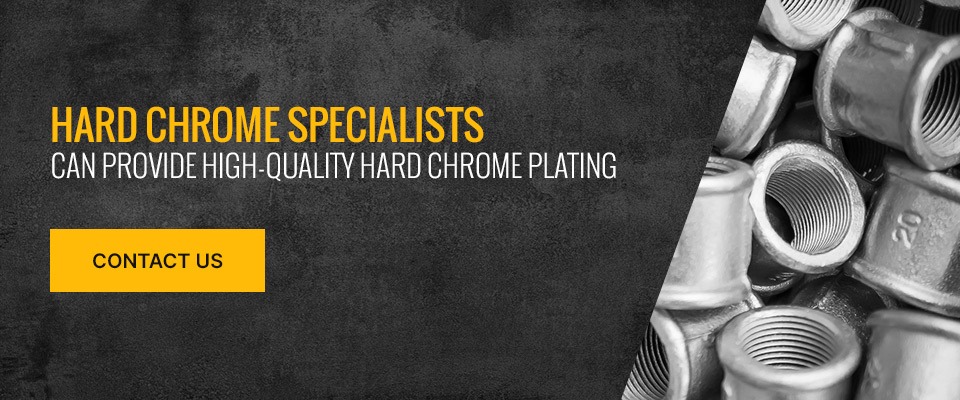The chrome plating process has many applications in the manufacturing, production and consumer goods industries. Commonly known as just "chrome," chrome plating provides a protective coating and shiny luster when applied to metal parts and products. Chrome plating can have decorative purposes or can enhance the desirable properties of machine components. You can achieve these two goals with different types of chrome plating — decorative chrome plating and hard chrome plating.
You may be wondering, "What is decorative plating, and how does it differ from industrial plating?" Each type of chrome plating offers distinct benefits for the chrome finish. This piece will outline the differences between decorative and hard chrome plating to help you select the best chrome for your project.
Explore the Rest of Our Hard Chrome Plating Guide:
The Difference Between Hard Chrome and Decorative Chrome Finishes
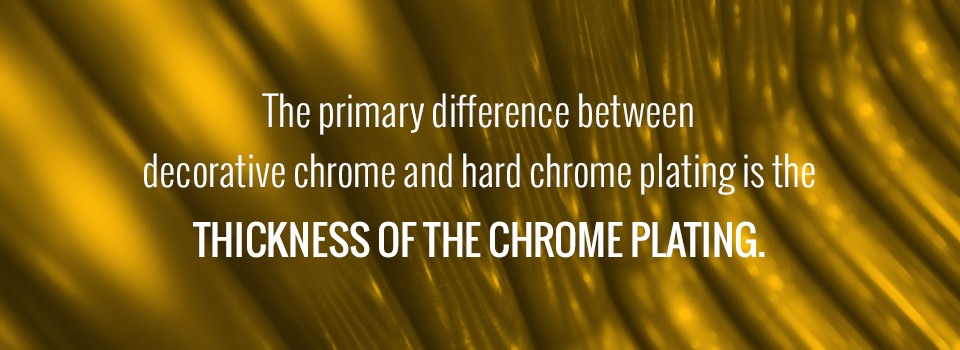
The primary difference between decorative chrome and hard chrome plating is the thickness of the chrome plating on the final product. Decorative chrome plating is thinner than hard chrome and is primarily for aesthetic appeal and as a protective coating. Hard chrome plating is thicker than decorative chrome finishes and is useful in many industrial applications for its strength, wear resistance, corrosion resistance and other beneficial properties.
Decorative chrome and hard chrome plating result from the same chrome manufacturing process but differ in their final properties and common applications. Chrome plating uses an electrolytic process that applies chromium plating to a metal component in an electrolytic bath at a rate of about 25 to 30 microns per hour. The substrate first gets cleaned thoroughly and, if necessary, treated with chemicals to improve the adhesion of the plating. The component then goes into a chrome plating vat for chrome dipping, where an electric current deposits chromium onto the substrate.
The electrolytic process and chrome dipping apply both types of chrome plating evenly to components of unusual shapes, sizes and textures. Hard and decorative chrome plating can adhere effectively to ridged or flat surfaces, in small holes or recesses and to cylindrical parts. With a large enough plating vat, you can apply chrome plating to metal components of nearly any size. The versatility of chrome plating makes it a popular chrome finishing choice for a wide range of applications in manufacturing and consumer goods.
What Is Hard Chrome Plating Used For?
A variety of industrial applications use hard chrome plating to increase the wear and corrosion resistance of equipment components. Also known as engineered chrome or industrial chrome, hard chrome plating reduces friction between machine parts and improves component durability. A hard chrome coating extends the life span of machine components and reduces maintenance downtime and expenses.
Hard chrome plating can also be useful in repairing damaged, worn or mis-machined parts. A component that is too small or has become worn down can benefit from applying a thick coating of hard chrome plating to return it to the correct dimensions. Stripping the damaged plating through a chemical process and applying new hard chrome plating can repair a damaged part.
Hard chrome plating can apply to a wide variety of base metals to strengthen an equipment component without compromising its original properties. Base metals that chrome plating can be applied to include steel, stainless steel, copper, brass, bronze, and more. Depending on the specific purpose, hard chrome plating can vary widely in thickness to meet precise project needs. The strength and durability of hard chrome plating make it extremely beneficial in a variety of applications, such as:
- Hydraulic cylinders
- Piston rings
- Rotors and shafts for pumps
- Molds, dies and other forms
- Rollers and bearings
- Valves and gates
- Compressors
- Press punches
- Lathe beds
- Mechanical and automotive parts
- Agriculture equipment
- Mining equipment
- Paper and timber equipment
- Textile and printing components
- Food and beverage equipment
Hard chrome plating can benefit nearly any machine component or part. Because of its low friction, hard chrome plating is effective for moving parts like rotors and pistons to reduce operating temperatures and improve the lifespan of equipment parts. Manufacturers of hard chrome plating can polish it to superior smoothness for rounded components like print cylinders and rollers while still providing exceptional resistance to wear when used with abrasive products like textiles, paper, limestone or sand.
Hard chrome is also easy to clean and sanitize, making it a popular choice for the food and beverage processing industry. The superior corrosion resistance of hard chrome plating makes it effective in pharmaceutical, chemical and oil and gas applications as well. Other industries where you can see hard chrome plating at work include printing, textiles, mining, agriculture, paper, manufacturing and many others.
What Is Decorative Chrome Plating Used For?
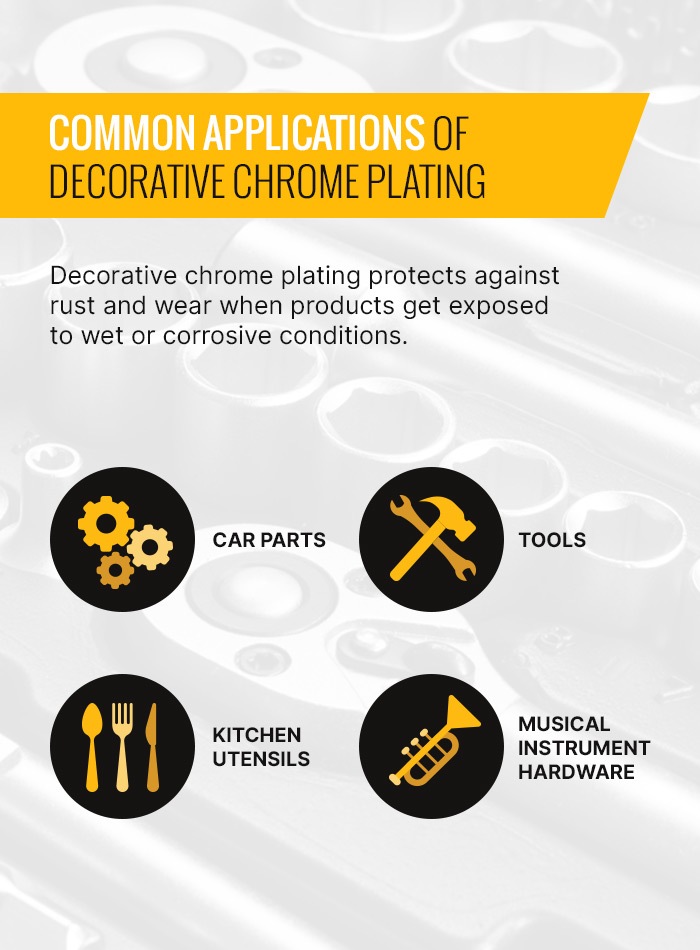
Decorative chrome plating has more limited applications than hard chrome plating, but serves an essential role in many industries. Although it does not offer the same strength and durability as hard chrome, decorative chrome finishes can still provide a thin protective coating when applied to automobile parts, tools and utensils. Decorative chrome finishes protects against rust and wear when products get exposed to wet or corrosive conditions.
Decorative chrome plating also provides a smooth and shiny appearance that is easy to clean, making it desirable for various consumer products. If used solely for aesthetic appeal, decorative chrome plating is sometimes applied using inexpensive imitation chrome finishes instead of actual chromium. Here are a few common applications of decorative chrome plating.
- Car parts: Decorative chrome plating is a feature of many car parts, such as bumpers, trim, rocker panels, door handles and grills. Applying decorative chrome plating increases the corrosion resistance of these parts so they will not rust when exposed to rain or snow. Decorative chrome also allows various finishing and buffing options to increase its shine and aesthetic appeal.
- Tools: Many tools and hardware — such as wrenches, pliers, sockets and hex keys — get finished with decorative chrome plating to improve their durability and wear resistance. Tools with chrome plating are suitable for use in harsh environments without damage.
- Kitchen utensils: Decorative chrome plating can apply to metal kitchen utensils — such as spatulas, tongs, knives, spoons and forks — to increase their corrosion and heat resistance. Kitchen utensils with chrome plating are easy to clean and provide durability for long-term use. Shiny chrome kitchen utensils also offer aesthetic appeal for home cooks and chefs alike.
- Musical instrument hardware: Hardware for guitars, clarinets and other musical instruments sometimes receive a thin coating of decorative chrome plating for enhanced appearance and durability.
You might hear people call decorative chrome plating nickel-chrome plating, as it gets applied over nickel plating rather than directly to the metal substrate. In some applications, copper plating also gets first to improve the strength of the final product. Decorative chrome plating is very thin compared to more durable hard chrome plating, typically measuring just a few millionths of a meter.
What Is Hard Chrome Plating?
Hard chrome plating is an electroplating process that involves applying a layer of chromium to a surface by submerging it in a chromic acid solution. Hard chrome plating can increase the durability, hardness, wear resistance and corrosion resistance of metal components for more effective use in machinery and equipment. It is possible to apply chrome plating without altering the properties of the original component, and deposit it in the precise thickness necessary for a specific application. Hard chrome plating creates a surface that is very hard (68-72 Rockwell C), highly wear and corrosion resistant, has a low coefficient of friction, and very smooth and easy to clean. Here are some of the benefits of hard chrome plating and the desirable properties it offers.
- Superior hardness: Hard chrome plating is harder than most other industrial abrasives and metallic coatings. Measuring between 68 and 72 HRC, hard chrome plating can withstand demanding industrial applications and high stresses. Although decorative chrome plating technically possesses the same hardness as hard chrome plating — because it gets engineered with the same material and manufacturing process — decorative chrome is so thin it does not exhibit the same hardness properties in actual use.
- Durable thickness: Depending on the specific application, it is possible to apply hard chrome plating in various thicknesses to meet the project needs. Hard chrome plating between 10 and 500 micrometers will provide a hardness of about 68 to 69 HRC. Thick, hard chrome plating protects machine components against wear during regular operation or in harsh conditions, such as when exposed to corrosive chemicals. When used to repair damaged or worn components, manufacturers can apply hard chrome plating much thicker if necessary. It offers excellent resistance to abrasion and wear to extend component lifespan.
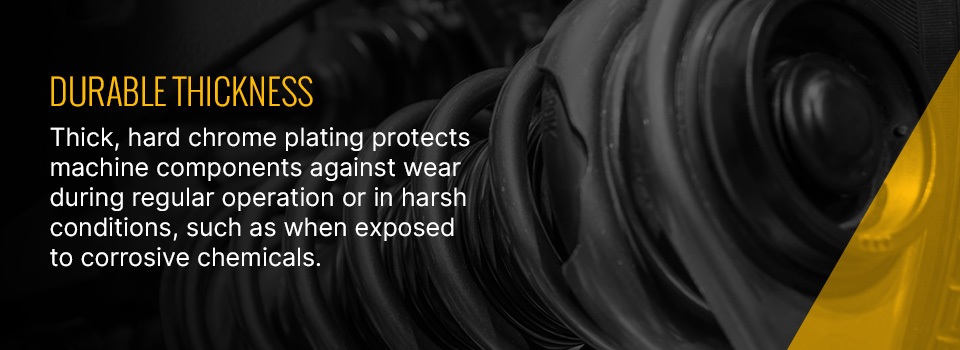
- Low deposition temperature: Applying hard chrome plating at low temperatures ensures the physical and mechanical properties of the substrate remain unaffected during the plating process. It is possible to deposit hard chrome plating without the risk of damaging precise metal parts and equipment components.
- Wide range of bases: Hard chrome plating can apply to a wide range of base metals to suit various industrial applications. Hard chrome plating often gets applied to stainless steel and other high-alloyed steels, as well as to alloys of copper, aluminum, titanium, bronze, brass and nickel. This flexibility makes hard chrome plating useful in many different industries, from food processing to automobile manufacturing.
- Excellent adhesion: Offering long-term durability, hard chrome plating has excellent adherence to many metal bases with minimal risk of flaking. To further improve adhesion, components get cleaned thoroughly to remove all contaminants before plating. Parts get treated with chemical solutions as necessary to ensure strong and lasting adherence of the chrome plating during the electrolytic bath.
- Low friction: Hard chrome plating creates very little friction when in contact with metals, graphites, carbons and polymers. When used on moving parts, hard chrome plating reduces friction and heat between equipment components. Lower friction and reduced operating temperatures can prevent parts from seizing and extend the lifespan of essential equipment components like pumps and hydraulic cylinders. The low friction and superior smoothness of polished hard chrome plating also ensure sensitive products do not get damaged from abrasion during processing.
- Wear and abrasion resistance: Because of its hardness and low friction, hard chrome plating is exceptionally resistant to wear. Hard chrome plating can be applicable to sliding components, in metal-to-metal contact applications and with rough, abrasive products like coal, sand and cement. Even in high mechanical contact stress, hard chrome plating holds up against wear and abrasion for long-term durability.
- Corrosion resistance: Hard chrome plating has extreme oxidization resistance, making it invaluable in the chemical, pharmaceutical and food and beverage industries. You can use hard chrome plating with most gases and organic acids for processing materials like fruits, beer, brines, milk, oils and fuels, molten glass and glue. Because they can withstand harsh sanitizers and cleaning agents, it is possible to thoroughly clean hard chrome-plated machine components for applications where sanitation is crucial.
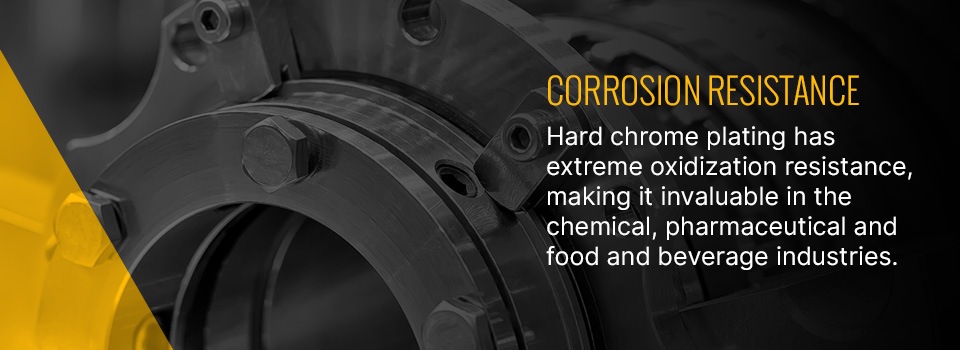
- Easy re-plating: If hard chrome plating does become damaged or eventually wears down over time, it is easy to remove with stripping chemicals and replace with fresh plating. You can strip old hard chrome plating without harming the substrate, allowing repeated re-plating to greatly extend the lifecycle of equipment components. Re-plating components with hard chrome reduce costs associated with replacing parts, which is especially beneficial for customized parts or difficult-to-acquire components.
- Variety of chrome finishing options: Hard chrome permits various finishing options including grinding and polishing. You can apply thick hard chrome plating, then precisely grind it down to meet the exact dimensions for parts. It is also possible to polish hard chrome to exceptional smoothness for applications that require very low friction and abrasion. For applications where aesthetic appeal is a concern, manufacturers of industrial chrome plating can polish and shine it for the same attractive look as decorative chrome.
These benefits of commercial chrome plating can enhance the existing properties of metal components for more effective use in many industrial applications. Companies can maximize the beneficial properties of their hard chrome plating by adjusting the thickness of the plating for increased hardness and durability. Through different chrome finishing techniques, hard chrome plating can provide the precise benefits a project requires.
What Is Decorative Chrome Plating?
Decorative chrome plating is primarily an aesthetic feature, though it also protects against corrosion and wear. However, because decorative chrome is so thin — ranging from about five to eight micrometers when applied over nickel plating — it does not offer as much durability as hard chrome plating. If you find yourself asking, "How long does decorative chrome plating last?" you should be aware that it can wear off over time. Here are the primary benefits of decorative chrome plating.
- Improved appearance: Decorative chrome plating provides an appealing shine and smooth, sleek surface. When used for consumer goods like kitchen utensils and tools, decorative chrome plating can increase their perceived value. Shiny chrome plating also makes cars and musical instruments more attractive.
- Corrosion resistance: Decorative chrome plating protects products from corrosion caused by chemicals or other oxidizing agents. This protective layer is particularly beneficial when using decorative chrome plating for car parts or other products intended for use outdoors or in wet environments.
- Easy cleaning: Due to its corrosion resistance, decorative chrome plating is easy to clean with household cleaners and chemicals. Its smooth surface also does not trap dirt and dust particles, so products with decorative chrome plating can continue to shine for long-term use.
- Some wear resistance: Decorative chrome plating can increase the strength of a product to some degree. However, because it is so thin, it is also fairly easy to damage. For example, decorative chrome plating on a bumper can get cracked in a car accident, exposing the metal underneath to corrosion and rust. Chrome-plated kitchen utensils can also degrade over time as the thin chrome layer wears off.
For applications where aesthetics and function are essential, decorative chrome plating can work well. Attractive and corrosion-resistant decorative chrome can enhance many consumer goods.
How to Remove Chrome Plating
While durable, chrome plating may eventually wear down or become damaged. Removing chrome can be done using specialized equipment or chemical solutions. However, due to the potential hazards, it is crucial to handle these processes with care. Be aware of the following when using hard chrome removal methods:
Specialized Machinery
While potentially expensive, methods like abrasive blasting and ultrasonic cleaning are efficient for chrome removal. Abrasive blasting, often used in automotive and construction work, employs a high-pressure stream of abrasive material to strip away the chrome coating. Ultrasonic cleaning uses high-frequency sound waves to vibrate the chrome, causing it to detach. Both methods require specific equipment and unique safety precautions.
Chemical Solutions
Chemical-based removal methods are generally more affordable but pose significant risks. Hydrochloric acid and sodium hydroxide are common choices. Hydrochloric acid can effectively remove chrome from metals but is highly corrosive. Sodium hydroxide or lye is also effective but highly caustic. Note that lye should not be used to remove chrome from an aluminum substrate, as it can corrode the metal and release hydrogen gas.
Reverse Electroplating
Reverse electroplating uses a combination of sulfuric and chromic acids, along with an electric current, to remove the chrome layer. This method is hazardous, producing toxic chemicals and posing electrocution risks. It should only be performed by professionals.
Which Plating Method Is Right for You?
Decorative chrome plating offers exceptional aesthetic appeal, while hard chrome plating provides superior strength and hardness, low friction and lasting durability. Both types of chrome plating are useful for different applications, and the best plating method for you will depend on your unique project needs. For consumer goods, decorative chrome plating can provide the necessary protection and desired appearance, while hard chrome plating is better-suited for high-stress industrial applications.
Frequently Asked Questions
Q: Is hard chrome plating a financially sound choice for industrial equipment?
A: Though the upfront cost for hard chrome plating may be higher than some alternatives, the investment pays off. The enhanced durability, reduced need for frequent maintenance and prolonged equipment life lead to considerable savings over time, making it a cost-effective solution for industrial applications.
Q: What is the difference between hard chrome vs. decorative chrome?
A: The primary difference lies in the thickness and purpose of the plating. Hard chrome coatings are typically thicker and designed for industrial applications, whereas decorative chrome coatings are thinner and used to enhance product appearance.
Q: Is chrome plating expensive?
The cost of chrome plating depends on several factors, including the size and geometric complexity of the parts and the desired thickness of the chrome coating. While chrome plating can be a significant investment, it often delivers long-term benefits in terms of durability and performance.
Q: How durable is decorative chrome plating?
A: Decorative chrome plating can maintain its aesthetic appeal for many years, depending on the quality of the plating process, the operational environment and the level of maintenance it receives. With appropriate care, it will retain an appealing shine for years under normal conditions.
Q: What is the expected life span of hard chrome plating on industrial equipment?
A: With appropriate care and regular maintenance, hard chrome plating can last for many years, even under demanding industrial conditions, ensuring continuous operation of machinery with minimal degradation.
Q: What is the typical time frame for completing a chrome plating process?
A: The time required for chrome plating depends on the desired thickness of the chrome layer. Some decorative chrome platings can be completed in minutes, while thicker coatings for industrial applications may take several hours to days. The thicker the chrome layer, the better the protection it offers.
Q: Can industrial equipment that has deteriorated be re-chromed?
A: Yes, re-chroming worn-out industrial equipment is an excellent way to restore its protective properties and enhance its appearance, significantly extending its usable life.
Contact Hard Chrome Specialists Today for Top-Tier Hard Chrome Plating
If your project requires durable metal plating, Hard Chrome Specialists can provide high-quality hard chrome plating to meet your needs. Hard Chrome Specialists is a leader in industrial chrome plating, and we use our expertise to deliver top-quality hard chrome plating for any application. Because we perform our chrome plating in-house, we have precise control over the quality of your final product. To learn more about hard chrome plating from Hard Chrome Specialists, contact us today.
Explore the Rest of Our Hard Chrome Plating Guide:

